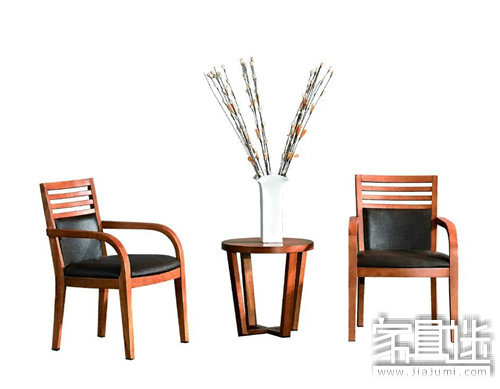The chair type is commonly referred to as an armchair or a standard armrest chair, depending on its structural design. Most chairs are designed for knock-down (KD) assembly, unless otherwise specified. While the structure of an armchair and a regular chair may be similar, the armchair typically includes additional support elements such as armrests.
Chairs are generally assembled using a combination of screws, dowels, and cam locks to connect the seat back, seat cushion, front legs, and frame armrests. This modular approach allows for easy transportation and assembly, making it a popular choice in furniture manufacturing.

Seat Frame
1. The seat frame is positioned beneath the seat cushion and serves as the foundational structure that connects the seat cushion, front legs, and the backrest of the chair.
2. It is typically composed of front and rear horizontal beams, along with left and right side supports, connected by wooden joints, rubber lock fasteners, and metal connectors to form a stable base.
3. The front and rear horizontal parts of the frame are usually made from solid wood, with the lower ends shaped according to customer specifications. Typically, the front horizontal beam and side supports curve outward slightly, while the rear horizontal part matches the curvature of the backrest.
4. To enhance structural strength, the inner sides of the left and right horizontal beams often feature three U-shaped grooves, allowing for better wood connections and reinforcement.
5. The connection between the horizontal beam and the backrest is usually done using a single piece of wood with drilled holes at both ends for secure fastening.
6. The rear frame and side supports must be tightly joined, ensuring that the rear ends of the side beams align flush with the backrest.
7. When assembling the front horizontal beam with the side supports, a mold is used to ensure consistent positioning of the clips and proper alignment with the front leg assembly.
8. For armchairs, the frame often includes through-holes on the left and right sides, which connect to the lower end of the armrest. These holes are usually 2–3 mm larger than the screw diameter to allow for smooth installation.
9. The top surface of the fully assembled seat frame should be flat, and the entire frame can be sanded as needed to achieve a smooth finish.
10. Holes connecting the front and rear legs around the frame should be drilled only after the entire frame is assembled to avoid misalignment and ensure precision.
11. The connecting wood pieces are placed at the four corners of the frame, linking the front, back, left, and right sections, as well as connecting to the front and rear legs.
12. The connecting wood is typically made from hard, solid wood, and minor imperfections are generally acceptable.
13. The connecting wood is usually divided into front and rear sections, with the angle of each end determined based on the overall shape of the seat frame. The ends of the connecting pieces must match the corresponding U-shaped grooves for a snug fit.
14. Wooden lock seats for the seat cushion are usually fastened with 8#*1 cam locks, and the depth of the countersink must be carefully controlled to ensure a secure and even finish.
Related reading: What are the production process standards for the back of the chair?
Armrests (for chairs with armrests)
1. Armrests are located at the upper edge of the seat cushion and are positioned on both the left and right sides of the chair.
2. They are typically attached to the side of the rear leg and the frame using screws. The screw holes on the rear legs are usually deep to provide strong and stable fastening.
3. Armrest designs can vary based on customer requirements, and their structural integrity must be tested to ensure durability and comfort.
4. The entire armrest should be smooth and free of rough edges, providing a comfortable grip and a polished appearance.
1. Renewable and Sustainable: Bagasse is a byproduct of sugarcane processing. It is made from the fibrous residue left after extracting the juice from sugarcane stalks. As sugarcane is a fast-growing plant, bagasse is a renewable and sustainable material.
2. Biodegradable: Bagasse is fully biodegradable, meaning it can break down naturally and return to the environment without causing harm. Unlike plastic containers, which can take hundreds of years to decompose, bagasse shushi tray can break down within a few months.
3. Reduced Carbon Footprint: The production of bagasse pulp containers requires less energy compared to plastic or Styrofoam containers. Bagasse is a natural material that does not require extensive processing or chemical treatments, reducing the carbon footprint associated with its production.
4. Waste Reduction: Sugarcane Bagasse sushi tray are made from a waste product of the sugarcane industry. By utilizing bagasse, these containers help reduce the amount of agricultural waste that would otherwise be discarded or burned, contributing to air pollution.
5. Compostable: Bagasse Pulp Container can be composted along with other organic waste. When properly composted, they can break down into nutrient-rich soil, contributing to the growth of plants and reducing the need for chemical fertilizers.
6. Non-toxic: Bagasse is a natural material and does not contain harmful chemicals or toxins. This makes bagasse containers a safe option for storing and serving food, without the risk of leaching harmful substances into the food.
Bagasse Pulp Sushi Container,Bagasse Sushi Tray,Pulp Sushi Container,Sugarcane Sushi Trays
EVER GREEN(ZHEJIANG)NEW MATERIAL CO., LTD / KUNSHAN GREENPACK CO.,LTD , https://www.changjingpack.com